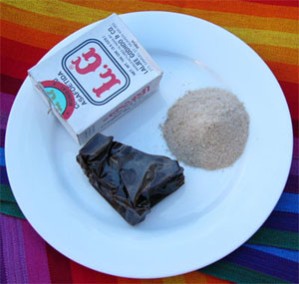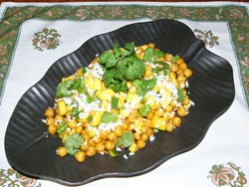Special Feature: Products Sally Recommends
Asafoetida
 Asafoetida is a hard aromatic resinous gum collected from certain species of giant fennels, plants of the genus ferula. It is sold in blocks or pieces as a gum and more frequently as a fine powder, sometimes crystalline or granulated. It is called devil’s dung because of its strong pungent smell due to the presence of sulfur compounds. Asafoetida is believed to have gotten its name from the Persian word aza (mastic resin) and a Latin word foetida meaning stinking.
Asafoetida is a hard aromatic resinous gum collected from certain species of giant fennels, plants of the genus ferula. It is sold in blocks or pieces as a gum and more frequently as a fine powder, sometimes crystalline or granulated. It is called devil’s dung because of its strong pungent smell due to the presence of sulfur compounds. Asafoetida is believed to have gotten its name from the Persian word aza (mastic resin) and a Latin word foetida meaning stinking.
The perennial asafetida plants are native to the region between the Mediterranean and Central Asia, especially Afghanistan and Iran. Three different species are used in the production of asafoetida, ferula asafoetida, ferula foetida and ferula narthex, each of which shows slight differences in color and properties. Even though most of the world’s production of asafoetida comes from the Middle Eastern regions of Iran and Afghanistan, India is the major consumer of this spice. When the plants are about four or five years old, they develop very thick and fleshy, carrot shaped roots. The resin is collected from the roots just before the plants start flowering in spring or early summer. The milky liquid soon coagulates when exposed to air. The color darkens when it is sun dried into a solid form.
Asafoetida is sold either as lumps or in powdered form. The lump asafoetida is the most common form of pure asafoetida. In making commercially ground asafoetida the resins are combined with small quantities of rice, barley or wheat flour to prevent lumping and to reduce the strong flavor. Processed asafoetida often varies in color and texture because of the difference in additives. It is available as either mustard yellow powder or sandy brown coarse powder.
Asafoetida’s use as a tenderizer and preservative for meat was known centuries ago. Asafoetida was a popular spice in Europe since the Roman times and a much-preferred spice of the Middle Ages. Iranian cuisine uses it for flavoring meatballs and in Afghanistan it is used in the preparation of dried meat. Although this spice is practically unknown in modern western cuisines, it is used in the United States and Europe in commercially prepared flavorings.
Asafoetida has remained a part of the Indian spice box for centuries and continues to be used both in cooking and in medicine in India. The ancient Sanskrit text “Kashyapa Samhita”, (circa 200 BC) mentions about the import of asafoetida from Afghanistan. The great Indian epic Mahabharatha (circa 400BC and 300AD) include graphic descriptions of dishes prepared with spices including asafetida. South Indian vegetable curries are often garnished with a large pinch of asafoetida sautéed in a spoonful of oil or ghee. When asafoetida is added to hot oil, it changes from its strong and powerful smell to an enticing oniony-garlicky aroma. Strict vegetarian diets of India forbid the use of onions and garlic, and asafoetida is used in their place for its distinct aroma. It is used in the cooking of various pulses, beans and certain vegetables, certain savory snacks, pickles and chutneys. As it helps to neutralize flatulence it is used in dishes prepared with various beans and other legumes. In Indian herbal medicine Ayurveda, asafetida is used to stimulate appetite and digestion.
The strong smelling and sparingly used asafoetida has an interesting history. Its predecessor silphium (also known as silphion or lasar), the wonderful spice from the region of Cyrene (now in modern Libya) was in great demand in ancient times. Silphium resisted attempts at cultivation and transplantation, which made it one of the major sources of revenue for Cyrene. The plant was valued for its many uses as food source, seasoning for food, and most importantly, as medication. However, true silphium became extinct by the end of 1st century A.D. According to geographer Strabo profit taking led to the decline of silphium. Two centuries later Pliny tells the end of the story of silphium in his Natural History. He called it “one of the most precious gifts from nature to man”.
In those days the spice was worth its weight in silver. Silphium was in great demand in the classical kitchens of Ancient Rome and Greece. Asafoetida was cultivated for both medicinal purposes and for the use as a spice. The Greek called it silphion medikon - Median silphium (silphium from Iran) and the Romans called it silfi. It said that the Cyrenaic silphium has a very healthy aroma, so that it is not noticed on the breath, but the Median and Syrian silphium are weaker and have a nastier smell.
Asafoetida, as a substitute for silphium emerged into prominence during Alexander the Great’s invasion of Asia that began in the spring of 334 AD. While crossing the northeastern provinces of the Persian Empire, his soldiers discovered a plant that was almost identical with silphium. Although not quite so good, it made a perfect substitute for silphium in tenderizing hard meat. Cooks interested in historical cookery recreate ancient Roman recipes today using asafoetida when silphium is called for.
Garbanzo Bean Salad
Kadala Sundal
 This simple and healthy bean salad is prepared as an offering at temples. Traditionally this recipe is prepared with Indian garbanzo beans that are smaller in size and have a brownish skin. Dried on canned garbanzo beans may be substituted.
This simple and healthy bean salad is prepared as an offering at temples. Traditionally this recipe is prepared with Indian garbanzo beans that are smaller in size and have a brownish skin. Dried on canned garbanzo beans may be substituted.
2 cup Garbanzo beans
½ teaspoon of turmeric powder
Salt to taste
2 tablespoons of vegetable, corn or canola oil
1 teaspoon mustard seeds
2 dried red chili pepper (serrano, cayenne or Thai), broken into pieces
or ½ teaspoon crushed red pepper
½ teaspoon asafoetida powder
A few fresh curry leaves
2 hot green chili peppers (serrano or Thai), thinly sliced (use less for milder taste)
Wash and soak the garbanzo beans overnight. Cook them with turmeric till the beans are very soft. Drain well, sprinkle with salt and set aside. Heat the oil in a large heavy-bottomed skillet and add the mustard seeds. When they start spluttering, add red pepper, asafoetida powder, curry leaves and green chilies and sauté for a minute or two. Add the drained chickpeas to the pan and stir continuously for a minute or two. Remove from the stove. Serve warm or cold.
A tasty variation of this recipe is to combine grated coconut and raw mango slices with it. After seasoning the oil with spices add two teaspoons fresh lemon juice along with the drained chickpeas to the skillet. Pan-fry for a minute or two while stirring continuously. Remove from the stove. Sprinkle one medium size raw mango cut into small cubes and ½ cup freshly grated coconut and stir gently to mix. Garnish with fresh cilantro leaves. Serve warm or cold.
![]()
A financial analyst turned freelance food writer, Ammini Ramachandran, writes about the history, culture and cuisine of her home state Kerala, India, on her web site http://www.peppertrail.com. Her recipes and articles have been featured in The Providence journal, Flavor & Fortune, www.leitesculinaria.com, and www.ThingsAsian.com. She is working on a cookbook about the vegetarian cuisine of Kerala against a backdrop of cultural and culinary history. She is a member of the International Association of Culinary Professionals and Culinary Historians of New York.
Note: This information was accurate when it was published. Please be sure to confirm all rates and details directly with the businesses in question before making your plans.



